How thousands of daytrippers arriving on giant cruise ships in search of the perfect Instagram shots are wrecking Italy’s most beautiful coastline

Perched among the brightly coloured houses on Manarola’s hillside, the Church of San Lorenzo is a reminder of this tiny Italian town’s ancient history.
Dating from 1338, the finely decorated church testifies to a time when the village was supported by its flourishing wine industry. Once Manarola’s greatest attraction, for centuries it attracted travellers from far and wide who marvelled at its Ligurian Gothic architecture and beautiful surroundings.
However, when the Mail visited this month, barely any sightseers were lingering outside. This might suggest that tourism is on the decline in Manarola, a Unesco World Heritage site, one of the five famous picture-postcard villages that make up the stretch of rugged coastline known as ‘Cinque Terre’ on the Italian Riviera. But that couldn’t be further from the truth.
Just a short walk down the winding cobbled hill from the church, hordes of rucksack-toting visitors are flooding out of Manarola’s small train station.

Colourful buildings in the tiny town of Manarola

An enormous cruise ship not far from the picturesque Cinque Terre coastline
They flock towards the tiny harbour, where others are already competing to get the perfect shot at one of Cinque Terre’s most ‘Instagrammable’ locations.
The rocky promontory of Punta Bonfiglio, with its breathtaking backdrop of buildings cascading down the cliffside toward the glistening sea, has become the focal point of tourism in the village.
A series of mini photoshoots are in full swing as tourists frantically preen their hair and strike poses for the camera.
While the Church of San Lorenzo was once a must-see on visitors’ itineraries, now it’s just another building in the background for the thousands who rush to Manarola to snap iconic social-media image before swiftly moving on.
Giancarlo Cielano, 79, who lives in the shadow of the church, has witnessed the rise of what locals call ‘fast tourism’ with a heavy heart. He remembers when visitors would stay for weeks, immersing themselves in local culture.
‘Before, the five villages were little-known,’ he says. ‘They were known by word of mouth. It has been a drastic change. Now, tourists come and go in a day. They take their pictures and leave. You no longer see the locals around. There’s no exchange, no greetings, no sense of community any more.’
He adds: ‘Normally, when there is a such transformation, it comes in stages, gradually over years. You don’t even notice if you do it well because people have time to adapt. But it’s happened over the space of two years. It’s stressful.’
Manarola, along with the other Cinque Terre villages of Riomaggiore, Corniglia, Vernazza, and Monterosso, was once largely isolated from the rest of the world, accessible only by footpaths, boats or the occasional train.
But today, the area is among Italy’s most visited destinations, attracting a record four million tourists in 2023, a staggering increase of one million on the previous year.
And this tourist boom feeds on itself as more and more tourists are lured to the coastline after seeing the photos and videos taken by previous visitors that increasingly saturate Instagram and TikTok.
Nowadays, getting there is straightforward. The Cinque Terre Express train connects the five villages with nearby Levanto town and the city of La Spezia.
One worker in Monterosso tells me many tourists buy a day ticket for €32 (£27) and stop at each village ‘for just an hour to say they’ve been there and get the picture’. The arrival of giant cruise ships has exacerbated the problem, flooding the narrow streets with thousands of visitors daily, most of them hopping from village to village on the train.
They descend in large groups, causing overcrowding on train platforms and making it difficult for locals to complete daily errands, such as attending hospital appointments. Extra attendants have had to be employed to help manage the vast crowds.
‘It’s impossible to get on a train in the peak times. We feel trapped,’ says a bakery owner who has lived in Manarola her whole life. ‘Cruise ships are the worst. They just come for ten minutes to take a picture. They are always in a rush and order takeaways, demanding that we “hurry” because they need to get back to their ship.’

A bakery owner who has lived in Manarola her whole life says that cruise ships are the worst as they come for just ten minutes to take a picture

More and more visitors are lured to the coastline after seeing the photos and videos taken by previous holidaymakers that increasingly saturate Instagram and TikTok
It’s a phenomenon that has left locals grappling with the issue of how to preserve their way of life in the face of this ‘hit and run’ tourism. While the elderly tend to retreat into their homes, the younger generations have left the villages altogether.
For people like Giancarlo, the impact has been jarring. Like many from his generation, he had looked forward to enjoying his retirement in Manarola, where he was born and brought up. He had settled near the marina to enjoy the tranquillity and rhythm of village life. However, as tourism boomed post-Covid, this peace was shattered.
‘I want to go in the sea, to take the boat, catch some fish and have a swim,’ he says. ‘I can go early in the morning but I have to leave before 10am because by then there are too many people.’
The increase in tourist numbers has turned the once-serene marina into a heaving mass of humanity and Giancarlo has been forced to retreat to an apartment up the hill. ‘Life has changed for the worse – fewer local inhabitants, too many tourists, lots of business but much less social life.’
He admits, though, that the tourists bring cash to the local economy. ‘We see that people around are earning money, so it’s OK, but it’s a sacrifice,’ he says.
His sentiments are echoed by other residents throughout Cinque Terre, who have seen their once peaceful villages transformed into tourist hotspots.
Consuelo Bordigoni, who runs the tourist information centre in Vernazza, is all too familiar with the new breed of visitor.
‘Tourists come with screen-grabs on their phones of the views they’ve seen on TikTok and Instagram, asking for directions so they can emulate the image,’ she says. ‘It’s all they seem to be interested in.’
One local newspaper highlighted a competition among bemused tour guides in Liguria for the most absurd questions asked by visitors – mainly Americans.
One guide recounted how cruise passengers disembarking in Portofino ask if they are in Positano, a village on the Amalfi coast some 450 miles away. Similarly, when they dock in Porto Venere, 60 miles down the coast, they will insist they are in Portofino.
Italian-American guide Karen Nilson is particularly frustrated by tourists in Cinque Terre who ask to try a ‘local Aperol Spritz’ instead of the region’s famous Sciacchetra wine. The now ubiquitous cocktail originates from Padua, on the other side of Italy.
Some of the ignorance is perhaps understandable. But the priorities of social-media tourism only seem to encourage it. Nilson tells of one Asian tourist who insisted they weren’t in Manarola because the colours of the buildings didn’t match a Photoshopped image she had seen online. Meanwhile, the crowds continue to grow – to the disenchantment of many who live here all year round.
‘Many are elderly, and they can’t go out until the evenings when it’s quieter. It becomes so crowded it’s crazy,’ Bordigoni says.
Local authorities have tried to manage the influx by increasing train prices but this has only sparked protests from disgruntled locals, who demonstrate carrying signs bearing the words: ‘Cinque Terre is not for sale.’
Bordigoni agrees that raising prices isn’t the solution. ‘Cruise ships need to work together to spread out the footfall across the day and maybe even limit the number of passengers they bring ashore at one time,’ she says.
Even the tourists responsible for the chaos are complaining. Alison Pariseau came to Manarola in search of the pastel-coloured homes and rock-jumping scenes she had seen on social media. Instead, the 26-year-old from Boston, Massachusetts, was reduced to tears after finding herself crushed by throngs of tourists.
‘I found it very overwhelming — the sheer volume of people . . . the pushing on the trains. I just couldn’t cope with how claustrophobic it was,’ she says.
Urgent talks are being held to find ways to prevent the villages from being overcome, with measures such as daily caps on visitors being mooted or schemes that would involve controlling access via ticketing systems.
Eugenio Bordoni, vice president of the Manarola Foundation, says it is a ‘complex phenomenon’ being driven by ‘digital word of mouth on social media’.
He says the only solution is to divert crowds to surrounding areas, adding: ‘In reality, there are many other places nearby that are just as beautiful. I don’t see any other way to decongest the area. It’s not as if you can remove the desire from people’s heads.’
Even so, other villages already have their own problems. An hour away from Cinque Terre, the village of Portofino – which has just over 400 permanent residents – is already deeply embroiled in the debate about over-tourism.
With its enchanting piazza and upscale boutiques, it has long been a jewel of the coast but in recent years it has been overrun by visitors. Last month, a staggering 14,000 tourists descended upon its tiny piazza in 72 hours via six colossal cruise ships.
But Mayor Matteo Viacava insists he has successfully negotiated the redistribution of ship arrivals, prioritising smaller, luxury cruises to ease the problem. ‘I believe this is the ideal standard for Portofino, which cannot be invaded by an excessive number of people,’ he told a local newspaper.
But he remains opposed to capping numbers or banning cruises, despite a petition from 700 locals demanding exactly that. ‘Portofino must be enjoyed by everyone . . . a restricted number will never be implemented,’ he argues.
His stance has raised eyebrows among locals, particularly as he closed Portofino’s famous public square for a private party to celebrate the engagement of Indian billionaire Anant Ambani and Radhika Merchant. Viacava has not disclosed whether the Ambanis paid for the privilege.

Alison Pariseau (left) and her friend, Ava Parent, both 26, from Boston, Massachusetts, were reduced to tears after finding themselves crushed by throngs of tourists

Giancarlo Cielano ahd his wife, Carla, have witnessed the rise of what locals call ‘fast tourism’ with a heavy heart
The mayor has previously introduced rules to ease congestion, including a ban on selfies in ‘red zones’ in the village. In an attempt to force tourists to show more respect, wearing swimwear in the village was banned, as was sleeping on public benches. Both offences carry fines of up to €500 (£420).
But when I was there last month, as selfie-stick-wielding tourists took pictures in the congested piazza and people alighted from ferries in their bathing suits, no such fines were being issued.
Perhaps the police were too busy enforcing the mayor’s new crackdown on air-conditioning units. A number of them have been illegally installed on the exterior of Portofino’s iconic pastel buildings, a practice that he claims is sullying the village’s beauty.
The irony is not lost on locals, who watch as the constant flow of giant ships disgorges endless thousands more passengers.
One letter to daily newspaper Corriere Della Sera captures the growing frustration over the mayor’s priorities: ‘The mayor has announced his battle against air conditioners which disfigure the village… But then I turn around and I see giant cruise ships, a couple every day disembarking 14,000 passengers in 72 hours.’
The writer added that the crowds were ‘crushed like anchovies in a few square metres’.
Despite the rising discontent, Portofino is set to be visited by 18 more cruise ships this month and a further 15 in October, bringing the yearly total to a record 117. As these ships depart, many more will plot a course for Cinque Terre, those beautiful and ancient fishing villages that are so ill-prepared to accommodate them.




